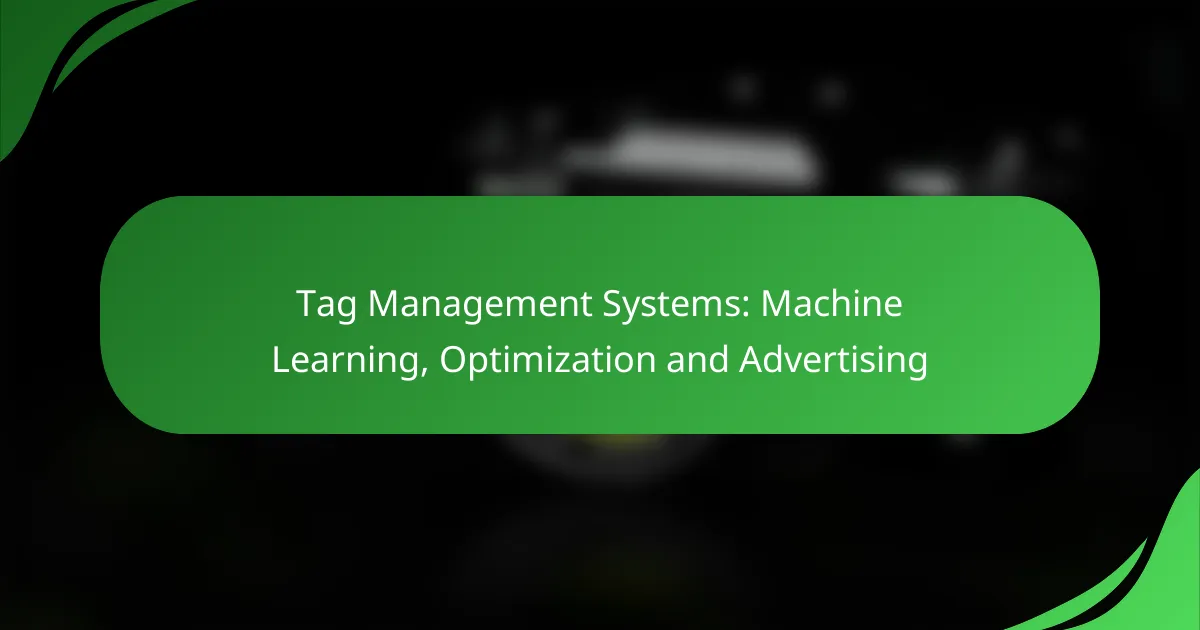Tag Management Systems (TMS) are revolutionizing the landscape of digital marketing by enabling marketers to efficiently manage and deploy tags across various platforms. By streamlining processes and enhancing data accuracy, TMS tools like Google Tag Manager and Tealium iQ facilitate improved targeting and faster data collection, ultimately leading to more effective advertising campaigns. As these technologies continue to evolve, they provide valuable insights that drive better advertising outcomes in Canada and beyond.

How do Tag Management Systems enhance display advertising in Canada?
Tag Management Systems (TMS) significantly enhance display advertising in Canada by allowing marketers to efficiently manage and deploy tags across various platforms. This leads to improved targeting, faster data collection, and more effective campaign management, ultimately driving better advertising outcomes.
Improved ad targeting
Tag Management Systems enable precise ad targeting by allowing marketers to collect and analyze user data more effectively. By integrating various data sources, TMS can help identify specific audience segments based on behavior, demographics, and interests. This targeted approach increases the likelihood of engaging potential customers and improving conversion rates.
For instance, a Canadian retailer can use TMS to serve personalized ads to users who have previously shown interest in their products, thereby enhancing relevance and effectiveness. This targeted strategy can lead to higher return on investment (ROI) for advertising campaigns.
Real-time data collection
With Tag Management Systems, advertisers can gather real-time data on user interactions and campaign performance. This immediate feedback allows for quick adjustments to strategies, optimizing ad placements and messaging based on current trends. Marketers can track metrics such as click-through rates and engagement levels almost instantly.
For example, if a particular ad is underperforming, a TMS enables marketers to quickly modify the campaign or reallocate budget to more successful ads. This agility is crucial in the fast-paced digital advertising environment in Canada.
Streamlined campaign management
Tag Management Systems simplify campaign management by centralizing the control of multiple tags and tracking codes. This reduces the complexity of managing various advertising tools and platforms, allowing marketers to focus on strategy rather than technical implementation. A TMS can automate many processes, saving time and reducing the risk of errors.
Additionally, Canadian marketers can benefit from the ability to test and deploy changes without extensive IT involvement. This empowers marketing teams to be more agile and responsive to market changes, enhancing overall campaign effectiveness.

What are the key features of Tag Management Systems?
Tag Management Systems (TMS) streamline the process of managing and deploying marketing tags on websites. Key features include centralized tag management, version control, and integration with analytics tools, all of which enhance efficiency and data accuracy.
Centralized tag management
Centralized tag management allows marketers to manage all tracking codes and scripts from a single interface. This reduces the need for direct code changes on the website, minimizing the risk of errors and speeding up deployment times.
With a centralized system, updates can be made quickly across multiple pages or sites, ensuring consistency in tracking. This is particularly beneficial for large organizations with numerous digital properties.
Version control
Version control in a TMS enables users to track changes made to tags over time. This feature allows teams to revert to previous versions if a new tag implementation causes issues, ensuring stability and reliability in tracking data.
By maintaining a history of changes, teams can also analyze the impact of different tags on performance metrics, helping to refine marketing strategies based on data-driven insights.
Integration with analytics tools
Integration with analytics tools is crucial for maximizing the effectiveness of a Tag Management System. A TMS can seamlessly connect with platforms like Google Analytics, Adobe Analytics, and others, allowing for comprehensive data collection and analysis.
These integrations facilitate real-time data tracking and reporting, enabling marketers to make informed decisions quickly. It’s essential to ensure that the TMS supports the specific analytics tools used by your organization for optimal performance.

Which Tag Management Systems are popular in Canada?
In Canada, popular tag management systems include Google Tag Manager, Tealium iQ, and Adobe Experience Platform Launch. These tools help marketers efficiently manage and deploy marketing tags without extensive coding knowledge, enhancing data collection and advertising efforts.
Google Tag Manager
Google Tag Manager (GTM) is widely used in Canada due to its user-friendly interface and seamless integration with other Google services. It allows users to manage tags for analytics, conversion tracking, and remarketing without needing to modify the website’s code directly.
Key features include version control, built-in templates for common tags, and real-time preview options. Businesses can benefit from GTM’s ability to streamline tag deployment, reducing the time spent on updates and ensuring accurate data tracking.
Tealium iQ
Tealium iQ is a robust tag management system that offers advanced features for enterprises looking to enhance their data management capabilities. It provides a centralized platform for managing tags, ensuring compliance with privacy regulations like Canada’s Personal Information Protection and Electronic Documents Act (PIPEDA).
With its extensive integration options and customizable data layer, Tealium iQ allows businesses to create a more personalized customer experience. Organizations should consider the investment required, as it typically caters to larger businesses with more complex needs.
Adobe Experience Platform Launch
Adobe Experience Platform Launch is part of Adobe’s suite of marketing tools, designed for businesses that already utilize Adobe products. It offers a flexible framework for managing tags and integrates well with Adobe Analytics and other Adobe Marketing Cloud solutions.
This platform emphasizes user control and customization, allowing marketers to deploy tags based on specific audience segments. Companies should evaluate their existing Adobe ecosystem to determine if Launch is the right fit, as it may require additional resources for optimal use.

What are the benefits of using Tag Management Systems?
Tag Management Systems (TMS) streamline the process of managing and deploying marketing tags, leading to improved efficiency, data accuracy, and cost savings. By centralizing tag management, businesses can quickly implement changes and optimize their digital marketing strategies.
Increased efficiency
Using a Tag Management System significantly boosts operational efficiency by allowing marketers to manage tags without relying on IT support. This reduces the time needed to implement new tags or update existing ones, often cutting deployment time from days to mere hours.
With a TMS, teams can quickly test and deploy marketing tags, enabling faster iterations on campaigns. This agility allows businesses to respond to market changes and consumer behavior more effectively.
Enhanced data accuracy
Tag Management Systems improve data accuracy by reducing human error during tag implementation. A centralized platform ensures that tags are correctly configured and consistently deployed across all digital properties.
Moreover, TMS often includes built-in validation tools that help identify and rectify issues before they affect data collection. This leads to more reliable analytics, which is crucial for informed decision-making in marketing strategies.
Cost savings
Implementing a Tag Management System can lead to significant cost savings by minimizing the need for extensive developer resources. By empowering marketing teams to manage tags independently, businesses can reduce reliance on IT for routine tag updates and maintenance.
Additionally, the improved efficiency and accuracy provided by a TMS can lead to better campaign performance, ultimately resulting in higher returns on marketing investments. This financial benefit can be particularly impactful for small to medium-sized enterprises looking to maximize their budgets.

What challenges do businesses face with Tag Management Systems?
Businesses encounter several challenges with Tag Management Systems (TMS), including implementation complexity, data privacy concerns, and the need for ongoing training and support. These hurdles can impact the effectiveness of TMS in streamlining digital marketing efforts.
Implementation complexity
Implementing a Tag Management System can be intricate due to the need for technical expertise and careful planning. Businesses must integrate various tags across multiple platforms, which can lead to compatibility issues and increased setup time.
To mitigate complexity, companies should consider using a phased approach for implementation. Start with a pilot program that includes a limited number of tags, allowing for troubleshooting before a full rollout.
Data privacy concerns
Data privacy is a significant challenge when using Tag Management Systems, especially with regulations like GDPR and CCPA in effect. Businesses must ensure that their tag implementations comply with these laws to avoid hefty fines and maintain customer trust.
To address privacy concerns, organizations should conduct regular audits of their tags and data collection practices. Implementing consent management tools can also help ensure compliance while providing transparency to users about data usage.
Training and support needs
Effective use of a Tag Management System requires ongoing training and support for staff. Many employees may lack the necessary skills to manage tags efficiently, leading to potential errors and misconfigurations.
Investing in comprehensive training programs and resources can help bridge this knowledge gap. Additionally, establishing a support system, such as a dedicated team or external consultants, can provide the necessary assistance to ensure smooth operations and troubleshooting.

How to choose the right Tag Management System?
Choosing the right Tag Management System (TMS) involves assessing your specific needs, integration requirements, and ease of use. A suitable TMS should streamline your marketing efforts while providing robust analytics capabilities.
Evaluate integration capabilities
Integration capabilities are crucial when selecting a TMS, as they determine how well the system can work with your existing tools and platforms. Look for a TMS that easily connects with popular analytics, CRM, and advertising platforms to ensure seamless data flow.
Consider whether the TMS supports APIs and third-party integrations. A system that offers a wide range of pre-built connectors can save time and reduce the complexity of implementation. For instance, if you utilize Google Analytics or Facebook Ads, ensure the TMS can integrate without extensive customization.
Assess user interface and ease of use
The user interface (UI) and overall ease of use of a TMS significantly impact your team’s efficiency. A well-designed UI allows users to manage tags without extensive technical knowledge, enabling quicker deployment and adjustments.
When evaluating a TMS, consider conducting a trial to assess its usability. Look for features like drag-and-drop functionality, intuitive navigation, and clear documentation. A system that requires minimal training will help your team adapt faster and reduce the likelihood of errors during tag management.



